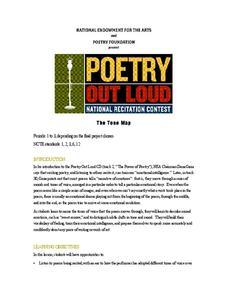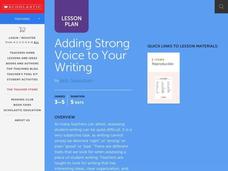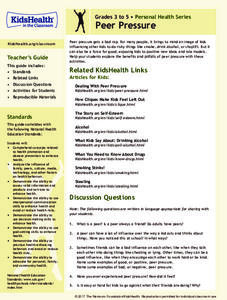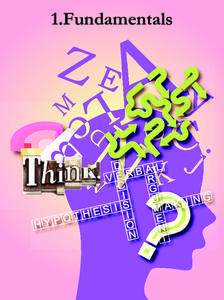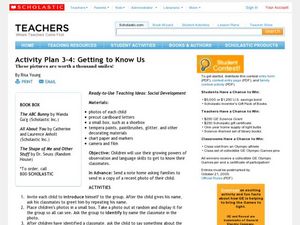Angel Island Immigration Station Foundation
Exclusion "Act"ivity
Two simulations highlight the feelings individuals experienced when immigrating to Angel Island. During the first simulation, scholars listen to and answer questions, divided based on their answers. The second simulation pins learners as...
Curated OER
Halloween Literature Unit: Little Critter’s Halloween
Students are read Happy Halloween Little Critter, by Mercer Mayer. In this emotions lesson, students discover how their mood is often affected by their feelings. They discuss the story as a class and then work independently on a...
Curated OER
The Tone Map
Poems are meant to be heard. Hearing a poem being read enriches one’s understanding of the tone and mood of the piece. Introduce your class to the sounds of poetry with a packet that not only details how to use poetry recordings in the...
Curated OER
Adding Strong Voice to Your Writing
Identify examples of strong voice in popular picture books. Young authors add voice to their writing and revise their own writing. In addition, they share their writing with their peers.
Curated OER
Tone and Mood
How are mood and tone similar? Different? Help your readers understand the difference between the two with this helpful guide. On the first page, they read the definition for both tone and mood and identify words that are describe each....
Curated OER
Ad Busting
Debunk advertising myths by creating an opposing image. First, find an ad with a persuasive and emotional pull. Once you have identified the message, create a counter-advertisement that shows the opposite message. For example, if an ad...
HealthTeacher
Get More Sleep
Help learners identify habits that interfere with sleep and to understand the importance of adequate rest and its impact on not only physical health, but also emotional wellbeing.
Nemours KidsHealth
Stress: Grades 9-12
Everyone feels stress from time to time, but how can you move past it? A seven-page packet of activities guides high schoolers through the process of recognizing and managing their stress. The resource includes discussion topics, a quick...
National History Day
Propaganda Posters of World War I: Analyzing the Methods Behind the Images
The power of a picture. During the events surrounding World War I, propaganda posters were widely distributed in American society to sway the emotions of its citizens. By analyzing World War I propaganda posters in the first installment...
Curated OER
Character Attributes in Writing
Third graders analyze the importance of characters in fiction writing and performances. In this theatre instructional activity, 3rd graders identify the important characteristics of a fictional character and how to portray a character...
Curated OER
Say Hi to Haibun Fun
What is a haibun? With this interesting lesson, writers will experience the Japanese writing form haibun, identify elements important to Japanese writing styles, analyze a haibun, and compose their own. Different from the typical journal...
Curated OER
A Happy Time
Second graders listen to stories about feelings and identify their own feelings during certain times of their lives. In this a happy time lesson plan, 2nd graders explore writing elements as a way to communicate with a variety of...
Nemours KidsHealth
Conflict Resolution: Grades K-2
Learners complete discussion and activities to identify healthy ways of resolving conflicts. In this conflict resolution lesson, learners answer discussion questions, complete two conflict resolution activities, and one cartoon worksheet...
Nemours KidsHealth
Peer Pressure: Grades 3-5
Peer pressure is the focus of a lesson that challenges scholars to respond to several scenarios using responsible-decision making skills. Lesson one begins with a live-action example set by class members, followed by a discussion that...
Overcoming Obstacles
Finding Solutions
Middle schoolers apply all they have learned in the Problem Solving module by participating in a contest to see which group can build the tallest tower using only sheets of paper and masking tape.
Overcoming Obstacles
Adapting to Change
Peter Pan doesn't want to grow up and doesn't want to change. Many middle schoolers feel the same way. The first instructional activity in the "Looking to the Future" module underscores the concept that change is a natural part of life...
Anti-Defamation League
Mo’Ne Davis and Gender Stereotypes
A thoughtful discussion begins a lesson about sports and gender stereotypes. After defining stereotypes, scholars highlight how gender stereotypes often have adverse effects. To break through those stereotypes, the class gets to know...
Thoughtful Learning
Recognizing Bullying
Boost social awareness with an activity that challenges scholars to recognize bullying. Participants read 10 scenarios and respond after carefully examining behaviors such as body language, facial expressions, and frequency.
Teaching Tolerance
Using Photographs to Teach Social Justice | Exposing Homelessness and Poverty
Photos can capture a complete story in a single image. Class members closely examine a photo of a homeless camp and attempt to read the story told by the picture. They then read the caption for the photograph and compare their notes with...
Facing History and Ourselves
Protesting Discrimination in Bristol
Using the Bristol Bus Boycott as a case study, class members examine the strategies and levels of power protesters used to effect change. The two-day instructional activity concludes with individuals reflecting on the actions they might...
Education Bureau of Hong Kong
Fundamentals
"Fundamentals," the first lesson in a series of eight, introduces the basic concepts and strategies covered in a series of resources designed to teach high schoolers critical thinking skills. The worksheets and activities in this first...
Overcoming Obstacles
Listening
Focus, confirm, respond. Middle schoolers engage in a series of activities designed to help them improve their listening skills. They listen to and try to solve a riddle and play a version of the telephone game. Participants learn that...
Health Smart Virginia
Self-Awareness
Introvert or extrovert? To find out more about themselves, class members fill out an Introvert or Extrovert worksheet. Learners are also introduced to a decision-making model that enhances self-awareness.
Curated OER
Getting to Know Us
Students discover pictures are worth a thousand smiles. In this early childhood language arts lesson, students use their growing powers of observation and language skills to get to know their classmates.




